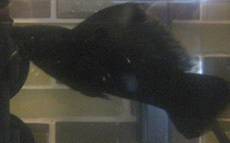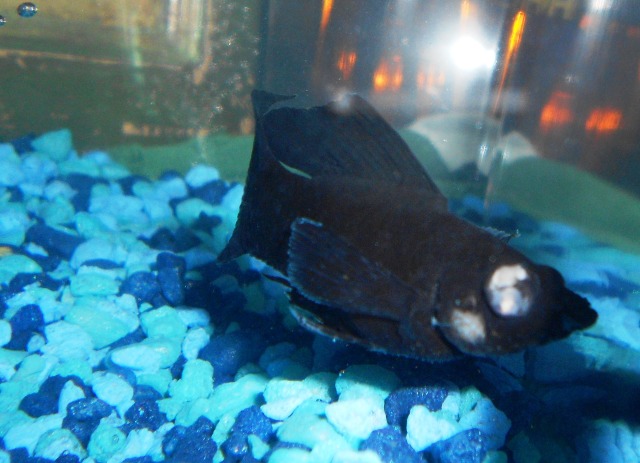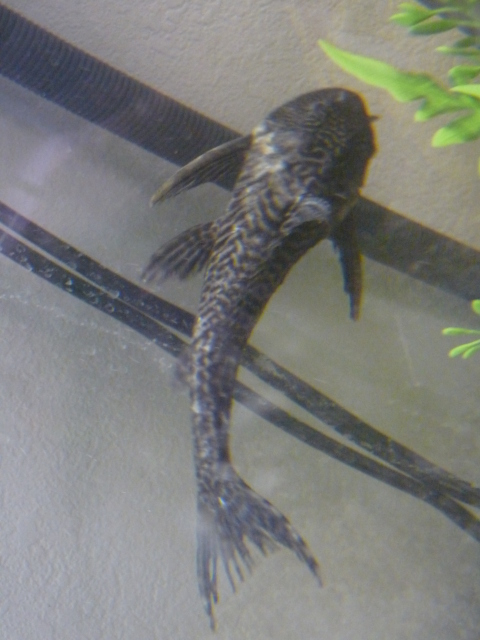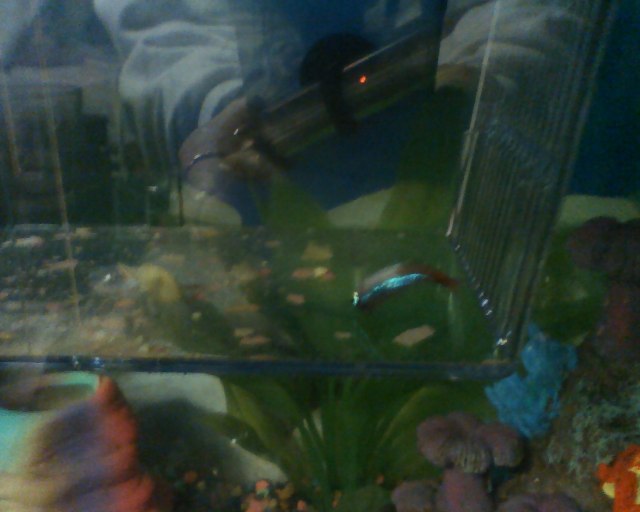QuestionHi Renee,
I am an experienced aquarist who is very familiar with the proper care of fish, having several tanks myself. I'm also pretty knowledgable about fish disease. For the last few months however, I've had a problem with my botiine loaches flashing.
The context of the situation is as follows: a few months ago, I foolishly added a new fish that I was unable to quarantine first. It brought ich with it, and when I observed the visible signs of white dots and flashing, I treated the tank (with a medication and dosage appropriate for scaleless fish), completed the FULL length of the treatment,and saw the spots go away. Around the same time, I also added new silk plants from an arts and crafts store, being sure that they would be safe if I used a technique to remove any chemicals/loose glue by soaking them in ammonia (additive free, pure), and of course, rinsing and rinsing them extremely thoroughly before putting them into the tank so as not to add ammonia. However, since my 9 botiine loaches (3 Botia kubotai and 6 golden zebra loaches) have continued flashing (as well as the golden zebras have been "greyed out" in color), I wonder if one of these two issues is still affecting them; that is, if they still have ich (though in these few months, still flashing, they have never once had any white spots), or if when I introduced the new plants (which I promptly removed at seeing their flashing) I unknowingly used an ammonia that DID in fact have additives that were harming them or burning their skin (to which I also responded by frequent, 50% water changes until I was sure that I had pretty much replaced the original water that may have had the chemical harmful additives).
I've heard the illustration that flashing is alot like the human coughing; it can be a symptom of so many things, illnesses or irritants of all kinds. However, I can't figure out what it is. I don't want to treat the tank again for ich, if I don't see spots. And there couldn't possibly be any chemical additives left, I don't think--especially since I have other loaches and scaleless fish in that tank with them, and only the botiine loaches are flashing. They don't flash while swimming or scratch against decorations, only against the bottom (small fine gravel), but they do it alot, and do it pretty violently. I know something is wrong, I just can't identify it and don't know what to do about it.
The tank is a 55 gallon, tropical community, 78 degrees, kept around 7 pH, with zero ammonia and nitrites, and low nitrates. Its well filtrated, with 2 60-gallon filters. The fish are not aggressive toward one another, and have many many hiding places. I don't overfeed or overstock the tank. I use half dose aquarium salt and add minerals (AragaMilk), I feed them very nutritiously, I use the same tap water for them as all my other tanks, and they are the only fish having this problem. Please help!
Thanks in advance,
Amanda
AnswerHi Amanda,
Sounds like you did all the right stuff with the treatment, but I would have additionally left the tank empty for four weeks, raising the temp to 85F to kill off any residual Ich. The problem is, soon as you put the fish in, even if there is a very weak population, they are going to lunch and snack on individuals most sensitive. Those being the soft scaled species, and/or those with low immunity.
So, if you had ich, even though you treated the entire tank, you may still indeed have a population.
Treatments only strong enough to cure a fish who has soft scales (usually around half the normal dose) are only strong enough to kill their ich, but a population still could thrive in a small amount, because Ich parasites harbor in plants, gravel and tank corners...anywhere small crevasses exist.
There might have been some in a different stage of hybernation which doesn't include the free-swimming stage (that is the stage the antiparasitic medication can treat...only in the free-swimming stage and that is why we treat once a week for a month, rather than for five days straight, as some medications suggest). We want to catch the little boogers when they're swimming.
With that said, I would surmise that the loaches do indeed still have a very minute population of Ich causing their skin to itch, POSSIBLY. Not for sure. There are other things, indeed, like you said. We can explore a few of those.
Nitrites & Ammonia literally burn the skin on fishes, as you know. If there is any trace amount of either one on the test strip, then the soft scaled fishes are going to be your first indicators. They will indeed scratch and itch.
Secondly, mine flash when the water is too cool. It revs up their system in some way. I stay around 78 for my tank, and not above 82 in summer, as that is too hot. I don't have a clue why tropical fish-keepers recommend keeping fish above those levels, when in the wild, 99.9% of our fishes kept in captivity are in the 78 degree F range, to 82F.
There can be too many nitrates as well. Anything above 5ppm is too much. Nitrates should not exist above that in a freshwater tank. Zero in saltwater, but for fresh, we can allow a hint of nitrates. In fact, without them, our biological filtration and biological bacteria will die. So, we do have to have some nitrates. The safe zone, in my opinion, is lower than on a test strip, however. It is 5ppm to 10ppm.
I suggest if you have any doubt about chemicals remaining, that you clean the tank thoroughly. I would wash the gravel through freshwater, additionally. It will remove particles which are trapped, and yes, some bacteria of benefit will die, but there will only be a very SMALL cycle, about a week later (change out 50% of the water every 2 weeks for a month), and the gravel should indeed be fine. Beneficial bacteria survive in small holes and crevasses and again will flourish because they already exist. Additionally, change out the filter pads, if you use HOB filters and if you use a canister filter, that may be why you have such high nitrates. You can let me know this later, and I'll explain further, but for now it's not really of significance.
7PH is perfect for your loaches in my opinion. I keep Botia. I love them. They are incredibly cute! :)
Okay, so the best thing to do with our fish is always to assume there is an issue, when we see flshing. Botias look flashy at times. They do flinch. It is a sign to each other, I believe. Some form of communication, as it is in other loach species, however rubbing on items is indeed indicative of something awry.
The problem with Ich and loaches is visibility is almost null. You can't really even tell they have it, because the spots are so minute. A good way to see them is to put one in a square jar and to view them through the glass with a magnifying glass. Indeed, often we do see the salted look, but the salts are very, very tiny. A lot of times, Ich begins only in the gill. It is not recognizable anywhere else and with Loaches that is a primary location to infect.
What would I do, if this was my aquarium?
1. Put all fish into a hospital tank with heat, filtration and I'd salt the water (not ich meds because they are far harder on soft sided fishe than salt is. I'd put in 1.5 to 2 teaspons per gallon of marine salt. I'd dissolve it thoroughly and raise heat to 82F. Treat 5 days. After the 3rd day, remove one third the water, and replace it with freshwater and no salt. This will lower the salt content, and what is left in the water will kill the free-swimming who hatch beyond that date. Until they go to their home aquarium, if you choose to leave them in the hospital a month(that info is in #2), you can additionally leave one teaspoon of salt/gallon in the hospital tank to prevent a further outbreak. It won't hurt the little loaches.
2. Leave the main aquarium vacant one month. Heat to 82F. Keep all filtration, etc, running. Meantime, you should consider just taking this opportunity to cycle it again (it would be a small cycle since all rock/gravel, etc., is already alive) and to start the tank fresh. You may leave inverts and snails in the tank to start the cycle if you choose this method. No medication is required for this treatment. Either way, leaving it standing one month will promote total Ich population death.
3. If you use a canister filter and your nitrates are above 5 to 10ppm ,please let me know. I will be happy to write a commentary to you to help you learn a little more about canisters. They are my nemesis, lol. They can be VERY good filters, but if not properly cared for (which NO manufacturer warns potential buyers about), they are nothing but nitrate factories. I'd love to share that with you, provided you're interested in it. :)
Please feel free to respond and let me know what you choose to do with your fish treatment and/or canister info, if needed.
It is great that you are perceptive to the flashing. So many people would just assume it's a loach behavior, when indeed, it is not entirely. Yes, they will flash, but not usually by rubbing on an object. They usually rub each other.
:)
Happy fish-keeping.
Renee

 Setting up a brackish tank
QuestionSailfin Molly?
QUESTION: Hi Renee,
You
Setting up a brackish tank
QuestionSailfin Molly?
QUESTION: Hi Renee,
You
 betta tank
Question
my betta tank
hi jaymie, i have a betta tank w
betta tank
Question
my betta tank
hi jaymie, i have a betta tank w
 Apparent Pop-eye in Adult Lyre Tail Dalmation Molly
Question
My Black Lyre Tail Dal
Hi,
I have a b
Apparent Pop-eye in Adult Lyre Tail Dalmation Molly
Question
My Black Lyre Tail Dal
Hi,
I have a b
 Plecostomus still sick
Question
sick pleco
I have a 70 Gallon tank 4 large tin
Plecostomus still sick
Question
sick pleco
I have a 70 Gallon tank 4 large tin
 Whats wrong with my fish? Can you please help me?
Question
Neon Tetra tail bent
Hi I was emailing
Whats wrong with my fish? Can you please help me?
Question
Neon Tetra tail bent
Hi I was emailing